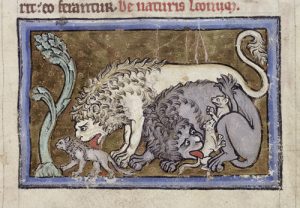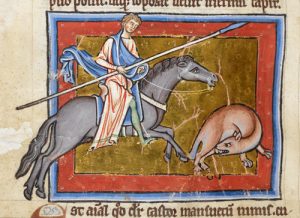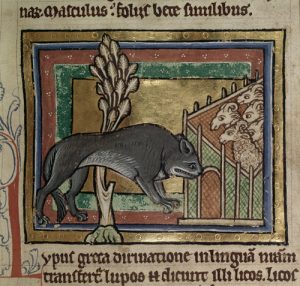The Medieval Bestiary is a very unique, interesting and elaborate medieval manuscript. It depicts as the title suggests, a number of beasts both real and mythological. It was created in the early thirteenth century approximately two hundred years before the invention of the printing press. The book contains eighty hand drawn images and has one hundred and twelve pages. Most of the pages are taken up by the images of beasts with Latin writing. The manuscript was made in Britain. One thing that makes this unique was that many of the manuscripts created during this time period were religious in nature while this manuscript is not. Since it is not religious in nature and depicts a variety of mythological, foreign and more local beasts the manuscript was probably created as a form of entertainment. Additionally, due to the time consuming artwork, expensive inks and the fact that the manuscript was handwritten it was probably very expensive, and made for royalty or at least the upper class. While the manuscript was definitely made for entertainment and to depict animals that people would not normally see, it also appears that it was created to depict the conflict between man and beast; showing man’s dominance over nature, as many of the images depict humans in conflict with animals, and much of Europe had been and currently was extirpating much of its wildlife.
Looking through the pages of the manuscript both fantastical and real creatures are depicted. The first image on folio 6 depicts a pair of lions with three cubs. While lions were not present in Europe at this time they had been located in the Balkans until they were driven to extinction around 100 AD. Another interesting occurrence between this image and the time period is that the menagerie at the Tower of London opened in 1204 and soon after lions first appeared at the Tower. While definitely a piece for entertainment there appears to also be some hidden meaning to the picture as these majestic beasts are now present, locked in cages to be seen on the whims of their captors. Man has caged the beast and asserted his dominance over some of the most dangerous beasts to walk the face of the planet.

Royal 12.C.xix, f. 6
On folio 10 V a much more commonplace animal is shown, a beaver. While the beaver had been commonplace in the British Isles for much of history, hunting had driven its numbers down and the traditional extinction date of the beaver in Britain is considered to be around 1200 AD. While the beaver may have survived in small isolated populations past that date it was functionally extinct at this point in time. Strangely, this manuscript was created at approximately the same time. This image shows man’s triumph over the beasts that roam the world. Whether or not the extinction of small harmless woodland creatures can be called a triumph is another story. Was this image a just a coincidence? Probably not. It was not only beavers that had been driven to extinction at this point in Britain and so the people probably had an understanding of extinction. This picture seems like it was created more to commemorate the extinction of the beaver as people would not have been as fascinated with the beaver when compared to more exotic animals and so its inclusion must have something to do with man’s triumph over nature. It has hidden meaning as unlike most of the other animals depicted, the beaver is plain.

Royal 12.C.xix, f. 10v
While man had hunted the beaver to extinction in Britain at approximately this time period, the same can not be said for the wolf. The wolf was considered a pest and a threat throughout history and throughout Europe. Unlike the beaver wolves still roamed Britain and were a threat to people and livestock. This can be seen in the image on folio 19 which depicts a wolf encroaching on some defenceless sheep which are stuck in a pen. Unlike the other three images which depict man successful against the beast, this image is different. The wolf is going after the sheep which are stuck in the pen. There is no man to protect the sheep, the wolf is a threat to the livelihood of the farmer who owns the sheep. Throughout the thirteenth century and later years wolves were persecuted with Edward I demanding the extermination of all wolves. Unlike many of the other animals of Britain who were eradicated like the bear, lynx and boar, the wolves managed to persist for a while longer surviving until the late 14th century and in more remote places such as Scotland and Ireland until the 18th century. This image is unique in that it is one of the only images in the manuscript that actively depicts an animal as a threat. It is interesting considering the wolf was the only large carnivore left in England and had managed to outlast all attempts to wipe them out. The image might also be incorporated as part of propaganda, the wolf does not look much like a wolf but more like a monster, and by depicting them like this instead of the majestic creatures they are it would be sure to rile people up.
Royal 12.C.xix, f. 19
Looking at this manuscript it is clear that it was made for the wealthy. Its hand drawn text and elaborate, colorful images mark it as something that would have been expensive, something for the elite. Lacking clear religious connotations and depicting a variety of animals it appears to have been made for entertainment. While entertainment was definitely one of its purposes as it depicts creatures both real, like deer, hawks and pelicans,and mythological like manticores and a phoenix; it has a more hidden purpose as well. It shows mankind’s dominance over nature. Not only does the manuscript depict man’s fight against the more mundane creatures but also the mythological ones as well. One image depicts the slaughter of a unicorn which may represent how man had managed to tame more and more of the world and there was less mysterious unknown, less danger from the wilds. The manuscript is intended to make its reader feel powerful, which makes sense considering it was made for the upper class if not the royalty. The author wanted to reader to feel good about themselves and if the owner liked the book they might commission more. The book was clearly made to depict man’s dominance over nature and man’s victory over the beasts that roam the world. This can be seen as the animals depicted have been subjected by man, captured, hunted or driven to extinction.
Works Cited:
A Natural History of Britain, iberianature.com/britainnature/miscellaneous/extinct-mammals-in-britian/.
Bestiary and various theological texts, 1st Quarter of 13th Century, MS, British Library, British Library Website, accessed 10/15/17, <https://www.bl.uk/catalogues/illuminatedmanuscripts/record.asp?MSID=8813&CollID=16&NStart=120319)
National Geographic, National Geographic Society, news.nationalgeographic.com/news/2005/11/1103_051103_tower_lions.html.
“The Disappearance of Wolves in the British Isles.” The Disappearance of Wolves in the British Isles | Wolf Song of Alaska, www.wolfsongalaska.org/chorus/node/230.
Raye, Lee. “The Early Extinction Date of the Beaver (Castor Fiber) in Britain.” Historical Biology, vol. 27, no. 8, 2014, pp. 1029–1041., doi:10.1080/08912963.2014.927871.
Shapland, Andrew. “The Minoan Lion: Presence and Absence on Bronze Age Crete.” World Archaeology, vol. 42, no. 2, 2010, pp. 273–289., doi:10.1080/00438241003672989.